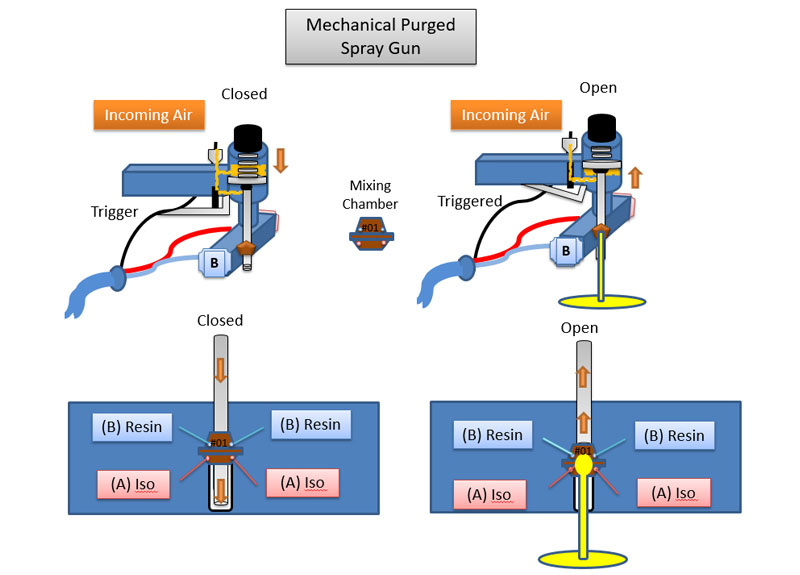Learn how the basic components are organized for a spray foam machine, generator, compressor for a stationary in-plant set up, or inside of a mobile spray foam rig.
The following is a look inside of the spray foam rig. Learn how spray foam equipment works. The insulation materials come in two separate 55 gallon drums, one part (A) Iso and one part (B) Resin. (See "How Much Does Spray Foam Cost?") Two transfer pumps are used to pump the Iso and resin material to the machine at 200 PSI. Transfer pumps have air motors that get their power from an air compressor. The air motors are attached to a pump leading into the drums. Once the materials are pumped to the machine, the in-line Y-filters are in place to pre-screen any contaminates. Once screened, the (A) and (B) materials are pressurized with a large air motor attached to two pumps. The air motor drive and two pumps increase the pressure to the material manufacturer’s recommendations. Typically 1,000 to 1,500 PSI for open and closed cell insulation spray foams.
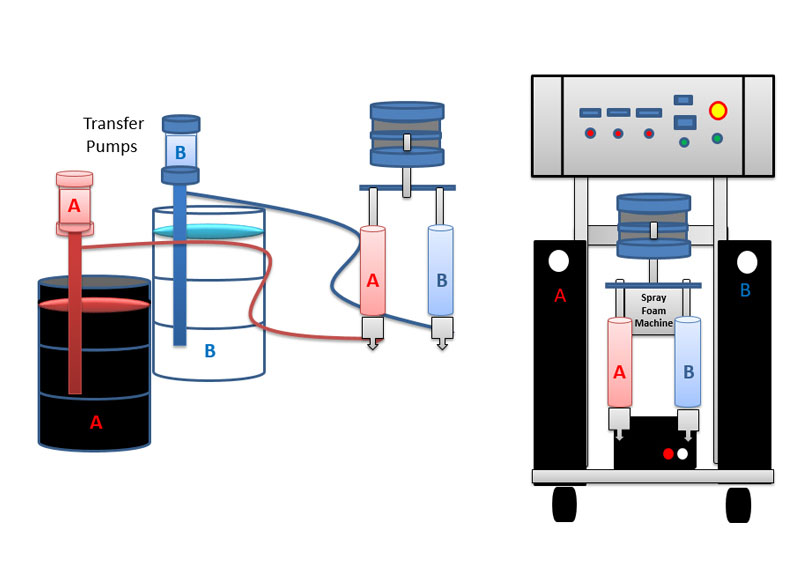
In this example, using a ½ inch air line, compressed air travels through the air regulator, which is regulated at 100 PSI. This line continues to the air motor, which is attached to the A and B proportioner pumps.
The three 3/8 inch lines attach to the A and B transfer pumps. The transfer pumps (A and B) pulls materials from the drums and pumps the material at approximately 200 PSI and take it to the Y-filters to pre-screen the material for contaminants. The air motor, attached to the A and B pumps, raises the pressure to the manufacture’s specifications. Open and closed cell foams are typically manufactured to be sprayed at 1000 to 1500 PSI. Once the material is pressurized, it passes through the fluid gages, so the pressure readings can be monitored.
From the gauges, the material flows through the A and B hoses and passes through the heated hose assembly which leads to the spray gun.
See spray foam equipment layouts for your mobile spray foam rig.
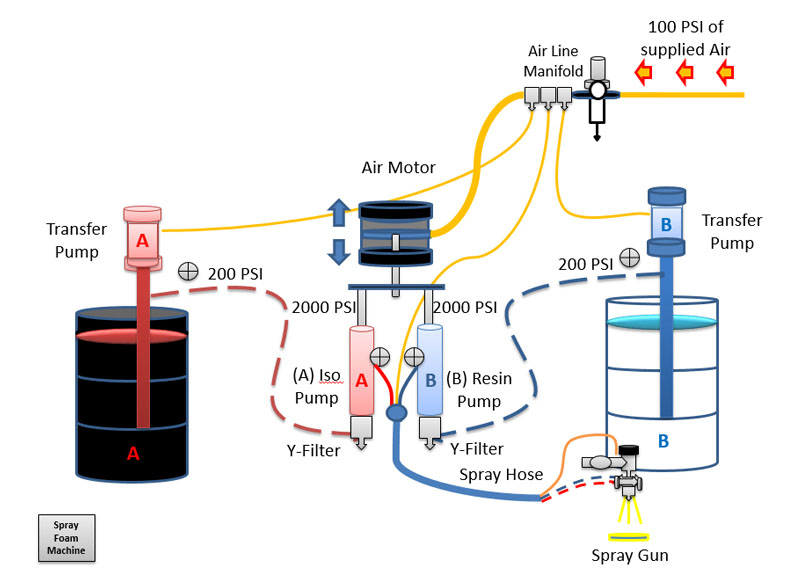
The Spray Foam Machine Heating System
The control panel contains the adjustments for heat and pressure. The digital temperature controllers display the temperature of the material as well as the temperature, via the sensing T.S.U. (temperature sensing unit) probes. There are three probes: one for each (A) and (B) pre-heater and one for the hose heat. When the A and B temperature controllers are turned on, each sends a signal to its respective relays in order to send a current to the fire rods. The fire rods conduct the heat within the A and B heater assembly. The hose heat controller senses the hose heat via the T.S.U. The hose controller tells the hose relay to send a current to the 220 Volt transformer. The transformer creates resistance through a copper wire hose wrap, or a copper and tin sleeved mesh wrapped within the hose assembly, throughout the assembly. The hose assembly interacts with the transformer so as to create an alternating current throughout the system. An analogy can be made by visualizing the way a thermostat controls a household furnace. When it is cold, adjust the thermostat until the temperature reaches the desired set point.
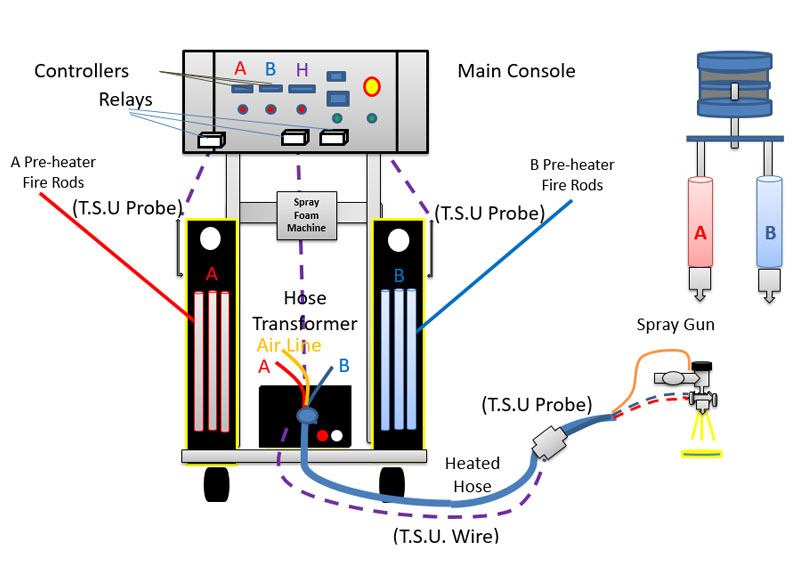
There are two basic types of spray guns: Air Purge and Mechanical purge. Air purged spray guns are popular among spray foam contractors for interior and exterior spray foam insulation applications. Air purged spray guns (shown in photo) work by a piston attached to a mixing chamber. Air is used to actuate the piston and purge the mixing chamber. In the non-triggered position, air is constant. When triggered, the air supply, traveling through the mixing chamber, is halted and replaced with the A and B chemicals. The material is then mixed and dispensed. The spray foam insulation material is manufactured through the spray gun. When the trigger is released the material supply is halted and replaced with air, purging the mixing chamber. While the basic principles of the spray guns are the same, the designs differ.
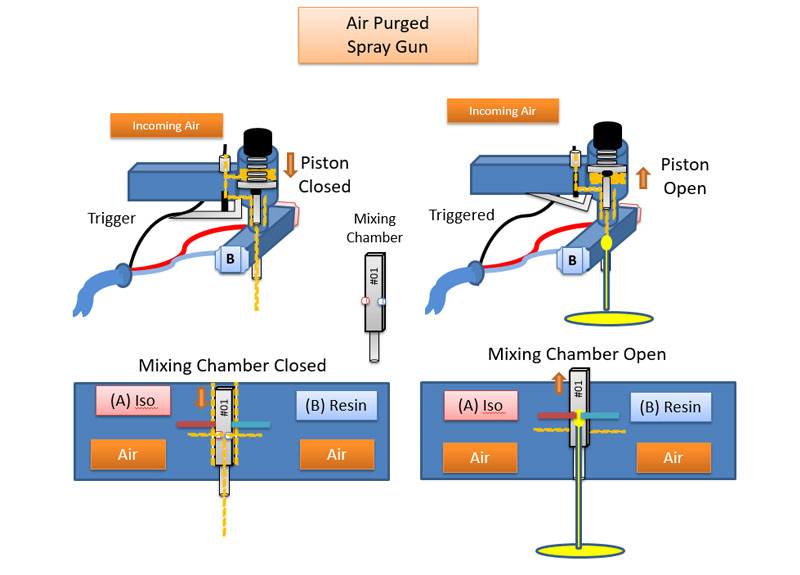
Mechanical purge spray guns are popular among spray foam contractors for interior and exterior spray foam insulation. Mechanical purge spray guns (shown in photo) work by a piston attached to a valving rod. Air is used to actuate the piston moving the valving rod through a mixing chamber. In the non-triggered position, the valving rod halts the material flow. When triggered, the piston moves the valving rod and the material is mixed and dispensed. Spray foam insulation is manufactured through the spray gun. Using an air purge spray gun or a mechanical purge spray gun is a matter of preference. Each has its own merits. Consult with a distributor or a supplier for specific uses.
